Rebuild of Hull #1 – This is the restoration of the very first Cal-25 hull built !!!
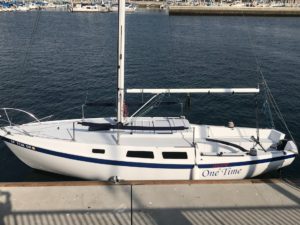 Well it finally appears that we have finally completed the project of rebuilding Cal 25 Hull # 1.
Well it finally appears that we have finally completed the project of rebuilding Cal 25 Hull # 1.
This endeavor started in the summer of 2017 when my son Scott and crewman Pat Graham found hull #1 languishing in a home dock on Naples Island in Long Beach, CA. Once they verified its authenticity as the “first Cal 25 off the assembly line” it was purchased for the grand sum of $600.00. The original plan was to trailer our current boat “One Time” (hull #50) to the Detroit Nationals, sell it there for $6000.00 and utilize the proceeds towards restoring #1. Thus far I have spent slightly north of $23,000.00 on the restore and are still counting, albeit at a slightly slower pace. My business acumen knows no bounds.
I have no intention of misleading you. As I write this somewhat lengthy description I often use the pronoun “we.” I did this because it was convenient to do so. In actuality the entire endeavor was the result of a division of responsibilities. My son did “ALL” of the work and I wrote “ALL” of the checks.
On to the restoration: Upon first inspecting #1 it did not appear to be in too bad of condition. In fact nothing could have been further from the truth. As the old saying goes, “you can’t bid what you can’t see.” Well, in this case we didn’t “see” a whole lot. The bottom was in such a state that it was surprising that it hadn’t already sunk. Blisters were everywhere. Termites infested virtually every piece of wood above the water line. Dry rot and water logged wood were prevalent.
Phase One:
The first order of business was to put a bottom on it to prevent sinking. Thereafter virtually all of the decking had to be torn out, repaired and/or replaced. The transom had to be totally rebuilt. Ditto with the mast step. None of the hardware was salvageable. Winches, cleats, chain plates, standing rigging and anything else that is affixed to the boat needed to be replaced. Previous owners drilled holes everywhere and each one had to be filled. New windows of course. There was a huge hatch hole on the front deck that had to be filled. I guess a previous owner had installed an air vent for ventilation or something. At any rate it had to go and it did, although filling the hole so that it was structurally sound was no easy project. The mast was salvageable but just barely. It had to be refurbished and and then painted. Not so lucky with the boom. It was tossed in the trash heap and replaced with a new one.
Most of this work was done while the boat was in the water which, as it turns out, caused some of our neighbors (unknown snitches) to complain to marina management that the boat was an eyesore and detrimental to the neighborhood. We were prime candidates to be piled on. Fortunately, the marina people worked with us and cut us some slack. In the end we didn’t disappoint them.
As sidelight while all of this was going on we actually took the boat out for a race. While heading for the starting line we were still drilling holes for equipment so that we could sail the darn thing. We didn’t win but it made for an interesting topic at the bar afterward.
Phase 2:
Once all of the above was completed the boat was in pretty good sailing condition. The deck was laid out exactly the way we wanted it and all of the equipment was in good condition. The problem was that it looked like hell. It’s not within me to own an ugly boat so this condition needed to be rectified. The whole exterior above the rub rail was painted with several coats of the best marine paint we could find. The interior wood of which much was rotted was repaired or replaced. It was then varnished or painted as appropriate. New cushions were purchased and new rugs installed.
Phase 3:
Back to the boatyard so we could give her the “racing bottom” she deserved. This meant that we could fare the bottom, eliminate the blisters, long board the heck out of it, put on a primer/sealer coat and then spray paint it to our hearts content. We then smoothed the whole thing out. Smoother then the proverbial “baby’s bottom.” While there we painted the hull. We also attached lifting points on the keel to facilitate lifting it out of the water. Things were looking more then just pretty good.
In conclusion there’s still a few minor things that need to be done to the interior. They’re all cosmetic in nature but as we all know you’re never really done tinkering with a boat. Are you?
Some of you, like my son and I, are in love with Cal 25s and don’t think there’s anything on the water that is better. We’re proud to be the owners of the first one ever made and even more proud that it is in “mint condition.”
Many names were considered but we settled on “One More Time” because it fit. Our plan is to trailer it to the Annapolis Nationals in September 2021. If you’re there and you want to take a look then feel free to do so. If you’re ever in Long Beach, CA and want to do likewise then give me a call and I’ll be glad to show you. We might even just take it for a tour of the harbor.
— Art Melendres
Related posts

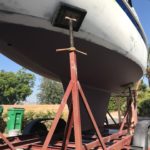
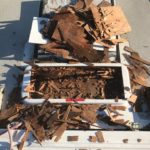
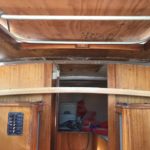
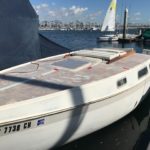
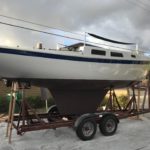
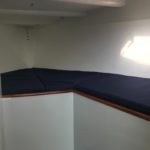
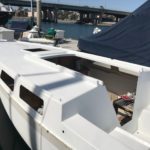
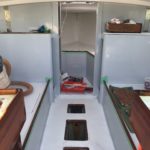
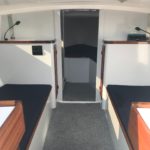
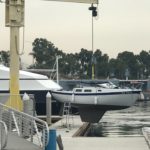
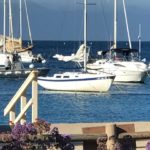
I happened upon this article and was in total shock to see what condition our old Cal 25 had come to, and amazement at the dedicated restoration!! She is indeed Hull 1 and Lapworth named her Two Bits even though the name was never put on the boat. My grandfather helped with the pop top design and was in that circle with Jack Jensen and Swede johnson, he designed the rooftop rig for North sails, Long Beach sea walls, among many other things. We tabernacled the rig and put her at his dock in the Rivo Alto Canal and the bend in the pulpit was intentional. I would clip guys on the boom and could drop and raise the rig like butter by myself. The bridge was so low, and with a higher tide, that the mast had to drop into that curve in the pulpit, the boom had to flop all the way down onto the lifeline, and then sometimes I had to jump my weight up to the bow to bounce the windex under the beams in the bridge. I had to almost lay down and use the concrete beams to pull the boat across. We loved that boat and my memory of her was a ‘cleanness’ no boat smells, airy, and with a nice North chute she was smooth as silk downhill coming home. When I moved to the central coast for school initially, we sold her for 1500 to a friend across the canal – she was so dialed for that spot – it was what we spent re-doing the cushions alone. I thought she was still well cared for (which now she is!) I learned to swim in that canal, and kept the moss off her bottom myself, never a barnacle or blister. Unbelievable! Btw, that crazy vent came with, but there was also a threaded cap, and as we anchored frequently it was used to pass the chain and line from a bucket down below. Great boat, great memories.
Second BTW, my grandfather had a ketch there, had to drop and raise both masts, and when the train trestle still crossed the entrance to Alamitos Bay, and there was no breakwater (still at that point I think), could punch out through the surf but had to use a sea anchor to straighten out between the pilings surfing back in.
Folks have got it easy now 😉 Scott Peterson
I have a ’69 Cal 25, in like pre-restored condition (no termites), and am parting it out or will sell as a whole package, located in Indianapolis, Indiana.
Happened on this. I have the same boat in restored condition. Do you have the original supports to prop up the top.
Love this story. I had a ’71 Cal 25 that I loved sailing on the Hudson River. She made an annual trip down river thru the Verrazano Narrows answer she screamed off shore in the Atlantic for most of a week. She was rigged for single handing back to the cockpit with a traveler that saved my bacon many times. Divorce and resulting hard times cost me her ownership. My heart will always be in that cockpit.